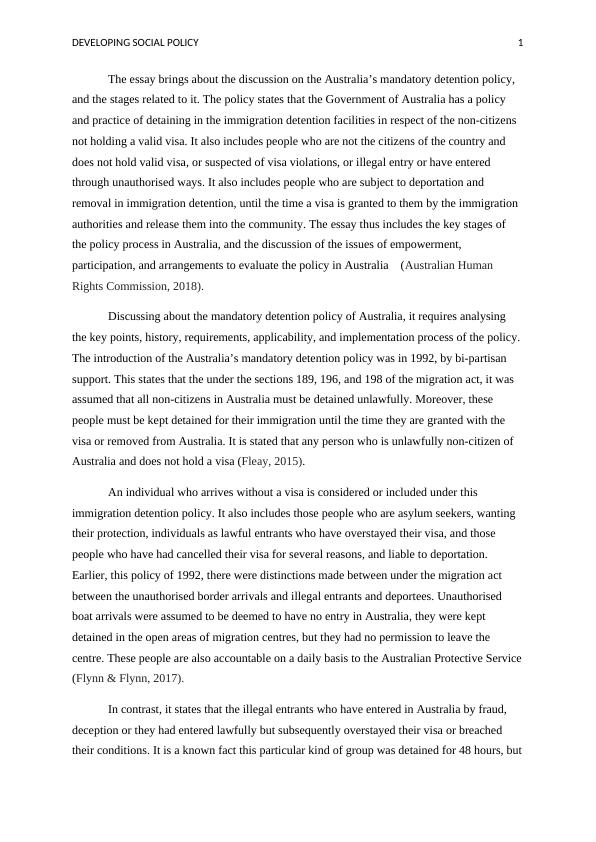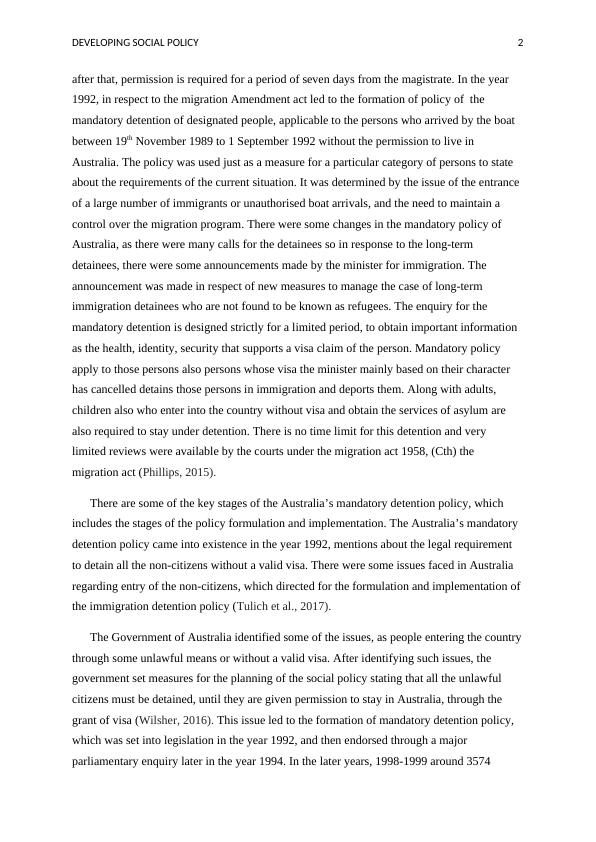Australia's Mandatory Detention Policy: Stages, Empowerment, and Evaluation
Added on 2023-06-04
7 Pages2172 Words337 Views
Running Head: DEVELOPING SOCIAL POLICY 0
Developing social policy
10/7/2018
Developing social policy
10/7/2018

DEVELOPING SOCIAL POLICY 1
The essay brings about the discussion on the Australia’s mandatory detention policy,
and the stages related to it. The policy states that the Government of Australia has a policy
and practice of detaining in the immigration detention facilities in respect of the non-citizens
not holding a valid visa. It also includes people who are not the citizens of the country and
does not hold valid visa, or suspected of visa violations, or illegal entry or have entered
through unauthorised ways. It also includes people who are subject to deportation and
removal in immigration detention, until the time a visa is granted to them by the immigration
authorities and release them into the community. The essay thus includes the key stages of
the policy process in Australia, and the discussion of the issues of empowerment,
participation, and arrangements to evaluate the policy in Australia (Australian Human
Rights Commission, 2018).
Discussing about the mandatory detention policy of Australia, it requires analysing
the key points, history, requirements, applicability, and implementation process of the policy.
The introduction of the Australia’s mandatory detention policy was in 1992, by bi-partisan
support. This states that the under the sections 189, 196, and 198 of the migration act, it was
assumed that all non-citizens in Australia must be detained unlawfully. Moreover, these
people must be kept detained for their immigration until the time they are granted with the
visa or removed from Australia. It is stated that any person who is unlawfully non-citizen of
Australia and does not hold a visa (Fleay, 2015).
An individual who arrives without a visa is considered or included under this
immigration detention policy. It also includes those people who are asylum seekers, wanting
their protection, individuals as lawful entrants who have overstayed their visa, and those
people who have had cancelled their visa for several reasons, and liable to deportation.
Earlier, this policy of 1992, there were distinctions made between under the migration act
between the unauthorised border arrivals and illegal entrants and deportees. Unauthorised
boat arrivals were assumed to be deemed to have no entry in Australia, they were kept
detained in the open areas of migration centres, but they had no permission to leave the
centre. These people are also accountable on a daily basis to the Australian Protective Service
(Flynn & Flynn, 2017).
In contrast, it states that the illegal entrants who have entered in Australia by fraud,
deception or they had entered lawfully but subsequently overstayed their visa or breached
their conditions. It is a known fact this particular kind of group was detained for 48 hours, but
The essay brings about the discussion on the Australia’s mandatory detention policy,
and the stages related to it. The policy states that the Government of Australia has a policy
and practice of detaining in the immigration detention facilities in respect of the non-citizens
not holding a valid visa. It also includes people who are not the citizens of the country and
does not hold valid visa, or suspected of visa violations, or illegal entry or have entered
through unauthorised ways. It also includes people who are subject to deportation and
removal in immigration detention, until the time a visa is granted to them by the immigration
authorities and release them into the community. The essay thus includes the key stages of
the policy process in Australia, and the discussion of the issues of empowerment,
participation, and arrangements to evaluate the policy in Australia (Australian Human
Rights Commission, 2018).
Discussing about the mandatory detention policy of Australia, it requires analysing
the key points, history, requirements, applicability, and implementation process of the policy.
The introduction of the Australia’s mandatory detention policy was in 1992, by bi-partisan
support. This states that the under the sections 189, 196, and 198 of the migration act, it was
assumed that all non-citizens in Australia must be detained unlawfully. Moreover, these
people must be kept detained for their immigration until the time they are granted with the
visa or removed from Australia. It is stated that any person who is unlawfully non-citizen of
Australia and does not hold a visa (Fleay, 2015).
An individual who arrives without a visa is considered or included under this
immigration detention policy. It also includes those people who are asylum seekers, wanting
their protection, individuals as lawful entrants who have overstayed their visa, and those
people who have had cancelled their visa for several reasons, and liable to deportation.
Earlier, this policy of 1992, there were distinctions made between under the migration act
between the unauthorised border arrivals and illegal entrants and deportees. Unauthorised
boat arrivals were assumed to be deemed to have no entry in Australia, they were kept
detained in the open areas of migration centres, but they had no permission to leave the
centre. These people are also accountable on a daily basis to the Australian Protective Service
(Flynn & Flynn, 2017).
In contrast, it states that the illegal entrants who have entered in Australia by fraud,
deception or they had entered lawfully but subsequently overstayed their visa or breached
their conditions. It is a known fact this particular kind of group was detained for 48 hours, but

DEVELOPING SOCIAL POLICY 2
after that, permission is required for a period of seven days from the magistrate. In the year
1992, in respect to the migration Amendment act led to the formation of policy of the
mandatory detention of designated people, applicable to the persons who arrived by the boat
between 19th November 1989 to 1 September 1992 without the permission to live in
Australia. The policy was used just as a measure for a particular category of persons to state
about the requirements of the current situation. It was determined by the issue of the entrance
of a large number of immigrants or unauthorised boat arrivals, and the need to maintain a
control over the migration program. There were some changes in the mandatory policy of
Australia, as there were many calls for the detainees so in response to the long-term
detainees, there were some announcements made by the minister for immigration. The
announcement was made in respect of new measures to manage the case of long-term
immigration detainees who are not found to be known as refugees. The enquiry for the
mandatory detention is designed strictly for a limited period, to obtain important information
as the health, identity, security that supports a visa claim of the person. Mandatory policy
apply to those persons also persons whose visa the minister mainly based on their character
has cancelled detains those persons in immigration and deports them. Along with adults,
children also who enter into the country without visa and obtain the services of asylum are
also required to stay under detention. There is no time limit for this detention and very
limited reviews were available by the courts under the migration act 1958, (Cth) the
migration act (Phillips, 2015).
There are some of the key stages of the Australia’s mandatory detention policy, which
includes the stages of the policy formulation and implementation. The Australia’s mandatory
detention policy came into existence in the year 1992, mentions about the legal requirement
to detain all the non-citizens without a valid visa. There were some issues faced in Australia
regarding entry of the non-citizens, which directed for the formulation and implementation of
the immigration detention policy (Tulich et al., 2017).
The Government of Australia identified some of the issues, as people entering the country
through some unlawful means or without a valid visa. After identifying such issues, the
government set measures for the planning of the social policy stating that all the unlawful
citizens must be detained, until they are given permission to stay in Australia, through the
grant of visa (Wilsher, 2016). This issue led to the formation of mandatory detention policy,
which was set into legislation in the year 1992, and then endorsed through a major
parliamentary enquiry later in the year 1994. In the later years, 1998-1999 around 3574
after that, permission is required for a period of seven days from the magistrate. In the year
1992, in respect to the migration Amendment act led to the formation of policy of the
mandatory detention of designated people, applicable to the persons who arrived by the boat
between 19th November 1989 to 1 September 1992 without the permission to live in
Australia. The policy was used just as a measure for a particular category of persons to state
about the requirements of the current situation. It was determined by the issue of the entrance
of a large number of immigrants or unauthorised boat arrivals, and the need to maintain a
control over the migration program. There were some changes in the mandatory policy of
Australia, as there were many calls for the detainees so in response to the long-term
detainees, there were some announcements made by the minister for immigration. The
announcement was made in respect of new measures to manage the case of long-term
immigration detainees who are not found to be known as refugees. The enquiry for the
mandatory detention is designed strictly for a limited period, to obtain important information
as the health, identity, security that supports a visa claim of the person. Mandatory policy
apply to those persons also persons whose visa the minister mainly based on their character
has cancelled detains those persons in immigration and deports them. Along with adults,
children also who enter into the country without visa and obtain the services of asylum are
also required to stay under detention. There is no time limit for this detention and very
limited reviews were available by the courts under the migration act 1958, (Cth) the
migration act (Phillips, 2015).
There are some of the key stages of the Australia’s mandatory detention policy, which
includes the stages of the policy formulation and implementation. The Australia’s mandatory
detention policy came into existence in the year 1992, mentions about the legal requirement
to detain all the non-citizens without a valid visa. There were some issues faced in Australia
regarding entry of the non-citizens, which directed for the formulation and implementation of
the immigration detention policy (Tulich et al., 2017).
The Government of Australia identified some of the issues, as people entering the country
through some unlawful means or without a valid visa. After identifying such issues, the
government set measures for the planning of the social policy stating that all the unlawful
citizens must be detained, until they are given permission to stay in Australia, through the
grant of visa (Wilsher, 2016). This issue led to the formation of mandatory detention policy,
which was set into legislation in the year 1992, and then endorsed through a major
parliamentary enquiry later in the year 1994. In the later years, 1998-1999 around 3574

End of preview
Want to access all the pages? Upload your documents or become a member.
Related Documents
Australia’s Mandatory Detention Policy Reportlg...
|7
|2165
|372
Mandatory Detention Policy in Australia: A Reviewlg...
|12
|2328
|205
SOC 103A: Bachelor of Applied Social Sciencelg...
|8
|1917
|79
Australian Detention Policy: Types, History, and Issueslg...
|7
|2049
|285
Essay on social policy Assignmentlg...
|7
|1783
|41
Assignment on Constitutional Lawlg...
|6
|1242
|95
